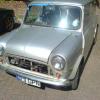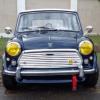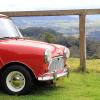
Although my main focus these days is building the wiring harness, there are still a number of other issues that I am rotating through. One item that needed a solution was finding a mounting point for the oil pressure and oil temperature gauge sending units. When I had a remote oil filter it was easy to just mount them within a sandwich filter. Now that I've decided to eliminate all that I lost any obvious location for the take-offs.
I'm not the only one facing this issue. Many BEC owners running R1 engines have chosen the oil cooler bolt as a good location, so I decided to follow suit. Mine was looking decidedly rough so i purchased a replacement and tapped it. It should work fine but with the engine installed in the subframe there is no way to remove/replace the bolt! That will have to wait. The good thing is that I now know where the senders will be mounted, allowing me to at least route the sender wires for now.

When the Power Commander V was released for the 5PW ('02-'03 R1 engine) I snapped one up. It includes an O2 sensor to allow closed loop tuning of the air/fuel ratio. This should result in me being able to skip expensive rolling road dyno tuning (until I want to get every last bit of power out of the engine at least), make more power, improve fuel economy and burn cleaner. Win/win. The other good news is that when I had the exhaust system fabricated the shop added an O2 sensor mounting bung! Unfortunately the installed location would point the sensor right into the front anti-roll bar that I later added. So much for thinking ahead.
After a lot of head scratching I found one (and only one) location that the O2 sensor could go that would not interfere with the engine, MinieXvo frame, front subframe, coolant lines, heater fitting, or front ARB. I carefully marked it, removed the entire exhaust with the help of a friend, and took all 10 feet of it to a local welder. He was able to TIG weld a new bung on. I reinstalled the system, installed the O2 sensor and I was very relieved to see that it fits! You can just see it buried down there.
Removing the exhaust system also allowed me to address another issue. The muffler was banging around and smacking into the bottom of the rear valence. I had already trimmed the valence some but the real issue was that the rubber muffler hangers were just too flexible. After much searching I found that Cusco makes a hanger identical to the two I had but in a firmer polyurethane, seen here in blue. by the way, the banging was happening just while rolling the car around the garage and driveway. I can only imagine the havoc had I actually been driving the car around California's 3rd world streets.
And here is the system re-installed using the new hangers. I need to adjust things a bit but I think this could work.
On to the next fun segment of the wiring harness - re-pinning the R1 ECU. In order to communicate with the ECU I would need to use this plug. Each of these wires terminate in a tiny socket. Although a bit grungy, I could just clip all of these wires a few inches from the connector and splice the rest of my harness into it. The reason I decided against this is that I would have to splice into every wire. This gives that many more failure points and adds a lot of unnecessary girth and weight to the harness right where I can least afford it - within the ECU tray.
I decided instead to figure out how to disassembe the ECU connector and repin the entire thing using new wiring. Thankfully I had two R1 harnesses - one to learn on (read: screw up and break) and one to actually use. Once I was able to disassemble it I got a good look at the sockets. Many hours of research online later and I found a near-perfect match - Auveco GM Micro-pack 100 W Series terminals (part number 20209). So for anyone out there messing with R1 ECU's I hope that helps.

This is the ECU plug prior to disassembly.
Partially disassembled.
All wires and sockets replaced. The sockets are made to accept 18ga wire, which matches with the original wiring. There are two exceptions - pins 3 and 25, which are both 14ga (?) ground wires. After spending way too many hours familiarizing myself with the R1 harness it appears Yamaha is always careful to go with the thinnest gauge wire they can reliably get away with. I assume they had a very good reason to run heavier gauge here so I decided to do the same. Problem is the sockets I have will not accept anything larger than 18ga. Yamaha used slightly different sockets that could accommodate heavier gauge wire. The easiest thing was just to re-use originals. Two splices are better than thirty-four!
This photo also shows the small white plastic plugs installed. These fill in any unused wire/socket cavities. My harness design does away with several more cavities than stock but after raiding the second harness, I had exactly the number of plugs required.
The final part of the assembly was pushing the top cap on. Every single socket has to line up perfectly in order for the cap to fully seat. After several attempts I realized this was not going to happen without some sort of tool. I finally worked out a solution. I held the cap an inch or two above the sockets. I slid a piece of welding wire down through the first hole in the cap. I then looked underneath the cap to guide the wire directly into the top of the socket. Once this was done to each socket I was able to slow force the cap downwards, the wire helping to guide the terminal into the corresponding cap hole. A bit time consuming but it worked the first time.
My reward? I now get to wire up the ECU's. This will likely be the worst part of the entire wiring job. There is a lot going on, not much space for it all to go in, and the final hooks up within the passenger compartment will all be under the passenger-side dashboard. It will be awkward and back-straining.
And here is the current state of the engine compartment. The bird's nest grows.
Edited by Joe250, 16 April 2014 - 09:21 PM.































































